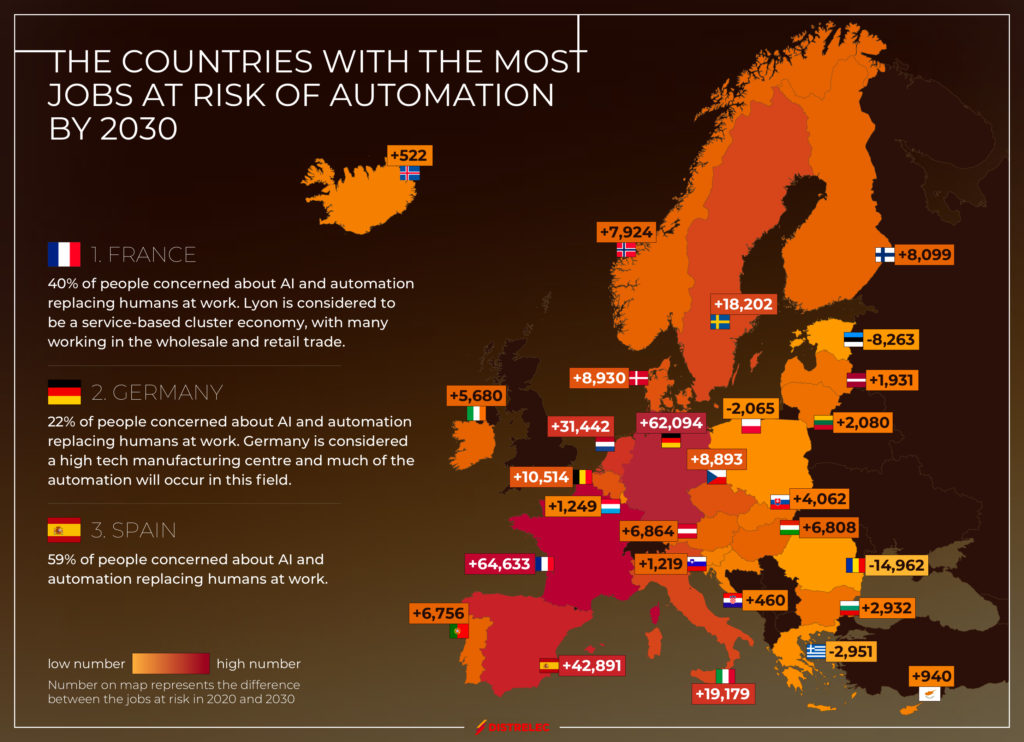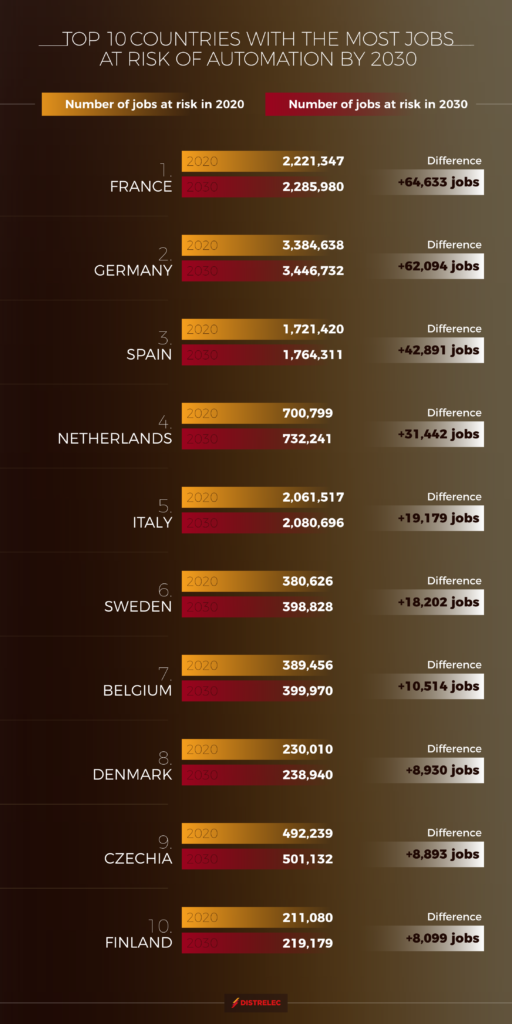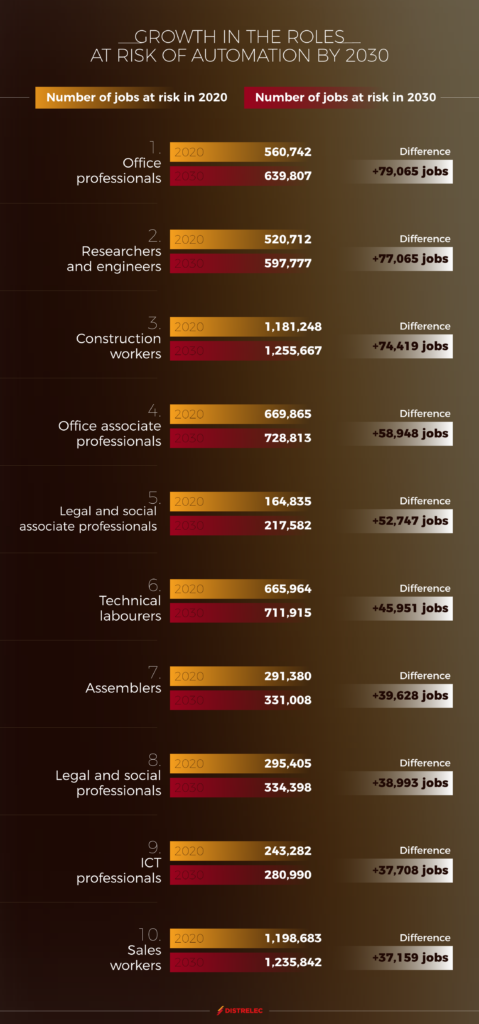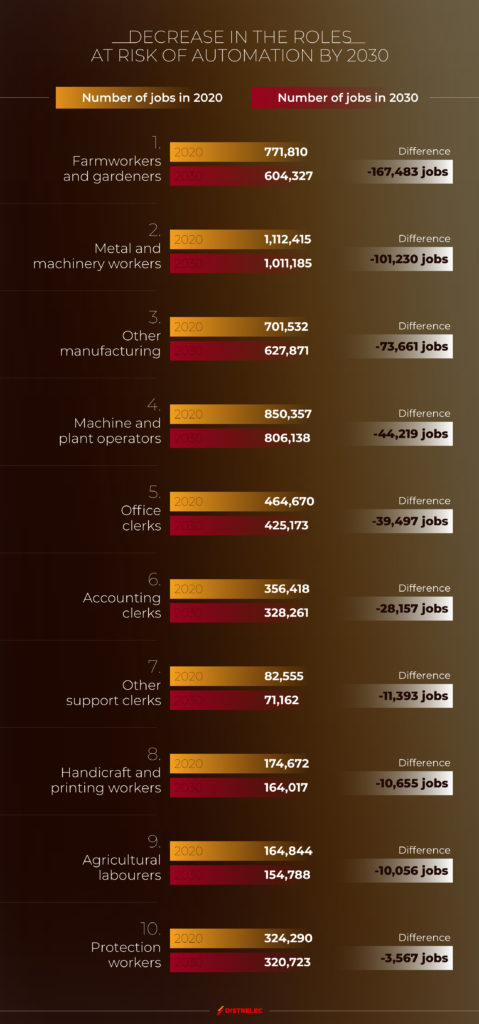It’s no secret that automation is changing the face of the current and future workplace. The market size of automation has increased consistently and is estimated to grow at a compound annual growth rate (CAGR) of around 9% until 2025. When it comes to the workplace, developments mean that the future landscape of work is changing and in turn the roles that we undertake.
As a result, Distrelec analysed the workplace landscape of 2020 including the number of roles in each industry in 2020 and the percentage share of employees at high risk of being replaced by automation. We then calculated how many more are set to be replaced by 2030 based on industry growth rates. This allowed us to create a picture of the European countries that will be affected the most by increasing automation based on the number of roles they have in each of the rapidly changing industries, allowing us to calculate the difference between the number of roles at risk in 2020 compared to the projected numbers in 2030.
Automation at work is often met with apprehension and fear, however, without adopting these technologies, many companies would no longer be able to compete and lose their market share, contributing to job losses over time. Despite scepticism, automation has the potential to improve the way we work, and particularly for those in manual roles working unsociable night shifts, a better work-life balance. The following countries with the most roles at high risk of automation by 2030, also reflect a changing landscape of work whereby these industries can look to continued growth and a better work environment.

France came in first for the difference between roles at risk of automation in 2020 and 2030, with 2,221,374 roles at risk in 2020 and 2,285,980 at risk in 2030 (a difference of 64,633 roles). Research from France shows that when analysing employment data from over 55,000 manufacturing firms, productivity was shown to have increased per individual in the firms adopting automation, however, there was also a reduction in the workforce. But, due to the improved productivity and relative cost reductions, overall employment at these companies actually increased. The study found that those companies that did not adopt automation saw a reduction in employment that was directly driven by increased relative costs and productivity, and a reduction in the market share. Despite these studies, data from Statista shows that 40% of employees surveyed in France expressed concern about artificial intelligence and automation impacting their work, showing that the workforce remains apprehensive about the potentiality of this technology.
Germany came in second place when it came to countries with the greatest difference in roles between 2020 and 2030, however topped the list when it came to the highest overall number of roles at risk of automation. In 2020, 3,384,638 roles were at risk of automation, compared to a projected 3,446,732 by 2030, representing the scale of change we can expect to see within the country’s workforce. Studies have shown that over 20 years of labour automation in Germany, there is no evidence that robots caused job losses in the country as a whole. Rather, there will be shifts and retraining in the types of work that employees will do, for example, handing over the parts of roles that can be automated to robots and putting more emphasis on the parts of the role that require human intervention. In some cases, robots have also been employed to cover night shift work, meaning that human employees no longer have to do as many antisocial hours.
In the third position, is Spain, with an increase of 42,891 roles at risk of automation between 2020 and 2030. Spanish employees also expressed significant concern over the role that artificial intelligence and AI will play in their work, with 59% of employees surveyed indicating a level of concern. The country even made headlines when a number of court rulings sided with workers who were fired after being replaced by more efficient machines, with experts claiming that some sort of legal reform must be in place to protect workers’ rights whilst also ensuring that the digital gap between businesses in Spain doesn’t continue to widen.

Our research found that while European countries like Italy had high overall numbers of jobs at risk of automation by 2030, the difference in the number of roles at risk between 2020 and 2030 was lower than in other countries like Spain, primarily because of the types of roles worked and available in those areas.


Increase in roles at risk of automation
In the face of automation, several industries are projected to grow, with the number of legal and social associate professionals predicted to grow 32%, customer clerks to grow 20.10%, and business managers to grow 18%. Office professionals came in first place for the biggest increase in roles at high risk of automation. Based on 2020 figures, 7% of employees within the sector were at high risk of automation, and with the industry projected to grow 14.1% by 2030, this will contribute to an additional 79,065 roles being at risk, with 639,807 roles being at risk in total.
In second place are researchers and engineers, 8% of employees were at high risk of automation in 2020 and the industry is set to grow by 14.8%. This means that there will be an increase of 77,065 roles at risk by 2030, with 597,777 roles at risk in total. On the lower end of the spectrum but still falling within the top 5, roles like construction work are predicted to increase by 6.3% despite having a 16% employee share of roles at high risk of automation in 2020. We ranked industries by the difference between roles in 2020 and 2030, rather than the number of roles at risk overall, however, industries like construction have a significant number of roles at risk overall, even if they rank lower in terms of the increase in roles. Construction work is the industry with the most roles at high risk of automation in 2030 based on the number of roles overall, with 1,255,667 roles being at risk.
In fifth place, the industry with the highest projected growth by 2030, is legal and social associate professionals. Roles in this field are expected to increase by 32%, and while the industry had a low risk of automation in 2020, with just 5% of employees being at high risk of automation, when ranked by the difference in roles between 2020 and 2030.
More roles found in the top 10 for the biggest increase in roles at high risk of automation by 2030 include technical labourers, sales workers, health professionals, teaching professionals, and cleaners.
Industries with roles set to decrease
Automation will change different industries in different ways, so it’s perhaps surprising that industries with a higher share of employees being at risk in 2020, would be ‘less at risk’ by 2030. This is because the industry is projected to decline, while others are projected to grow despite automation. Coming in at the top with the biggest decline in roles is the farming and gardening industry. Despite a 13% share of these workers being at high risk of automation in 2020, there will technically be fewer roles at risk in 2030, due to the projected industry decline of -21.7%. The future of farming in Europe will rely on many aspects being automated and going digital, which will allow the market to scale, however, manifests as a reduced need for human workers.
The key trend here is that the majority of the industries with a decreasing number of roles ‘at risk’ are traditionally manual ones at varying skill levels which had higher shares of employees at risk of automation in 2020. For example, in the second position were metal and machinery workers. 15% of employees in this industry were at high risk of automation in 2020, however, due to a -9.1% projected decline in roles by 2030, there will be ‘fewer’ roles at risk of automation in the coming years, primarily because some of the transition will have already occurred and there will generally be fewer roles available. When we rank positions by the number of roles at risk overall, metal and machinery workers come out in 4th, with 1,011,185 roles at risk by 2030.
What is surprising though, is that at number 5 sits office clerks. With just a 6% share of employees at high risk of automation in 2020 and a projected industry decline of -8.5% by 2030, there will be 39,497 fewer roles at risk. Office clerks are typically responsible for administrative duties, and are often instrumental to the smooth running of offices, despite some of their duties likely being automated by 2030.
Automation at work will play an instrumental role in the coming years, both in industries that are set to grow and adapt, and those where human input will be required less and less. Many roles will see a shift in how human roles will function, with retraining and additional learning being needed in some areas to better work alongside the roles replaced by automation. Our study shows the scale and the rate of change projected by 2030, particularly for those countries that will see the greatest differences in roles that are likely to be automated.
——————————————————————————————————————————-
Methodology
We used Cedefop data to find the employed population by sector and occupation across EU27 in 2020, and then calculated exactly how many roles were at risk based on the share of employees with high automation risk for each occupation. We then analysed projected growth by 2030 for each of these areas and calculated how many roles would be at risk by 2030 on this basis, analysing the difference between 2020 and 2030 results.











